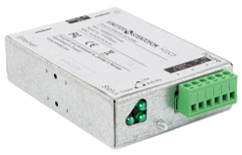FCDC3
Jump to navigation
Jump to search
Flowire Ethernet Converter
- One single-paired cable can be used to distribute power and data
- The cable hauls can be longer than standard ethernet cabling, reducing the need for switches and/or repeaters
- Up to 10 Flowire devices can be connected to the same 2-wire network structure
- Existing infrastructure can be used, even though only a single pair is available, which reduces the total cost of retrofit projects
- The Flowire Converter can be used with any Ethernet enabled device
The Flowire Converter enables Ethernet to run on the same two wires as power, providing simpler cabling and opens up for longer cable hauls. The Flowire Converter is also capable of powering Ethernet devices attached to it, such as IP intercom stations or IP cameras.
Highlights
- PoE-power forwarding enable/disable by switch
- Separate Power input – isolated from the PLC bus
- Several Flowire Clusters can be powered from same power supply
- Backwards compatible with FCDC1/2/TFIX after software upgrade
- Replacement for FCDC1 and FCDC2
Installation
Overview
| 1 | Status indicators | Indicates status for power, link and activity |
| 2 | Ground connection | Ground connection for grounding of the unit |
| 3 | Flowire line | Connections for Flowire network |
| 4 | Flowire Power | Connections for power |
| 5 | DIN mounting clips | Plastic clip to mount the Flowire Converter box to a DIN rail |
| 6 | Mounting holes |
| 1 | Password Reset Button | Pressing and holding this button will reset factory settings |
| 2 | "PoE-power forwarding" switch | PoE-power forwarding is enabled/disabled by this switch |
| 3 | Ethernet connection | Ethernet connection, with or without power |
| 4 | Alt. position for DIN clips | |
| 5 | DIN mounting clips | Plastic clip to mount the Flowire Converter box to a DIN rail |
Placement
Mounting
PoE-power forwarding
The FCDC-3 unit can forward the power received on the PLC line out to the spare pairs of the Ethernet port (PoE, mode B). The "PoE-power forwarding" is enabled or disabled by the switch located next to the ethernet port.
The power out on the ethernet port is not true PoE – the power is present at all time The PoE-power forwarding should be enabled only when you need to power the device connected to the ethernet port. In all other situations, the PoE-power forwarding should be disabled.}}

